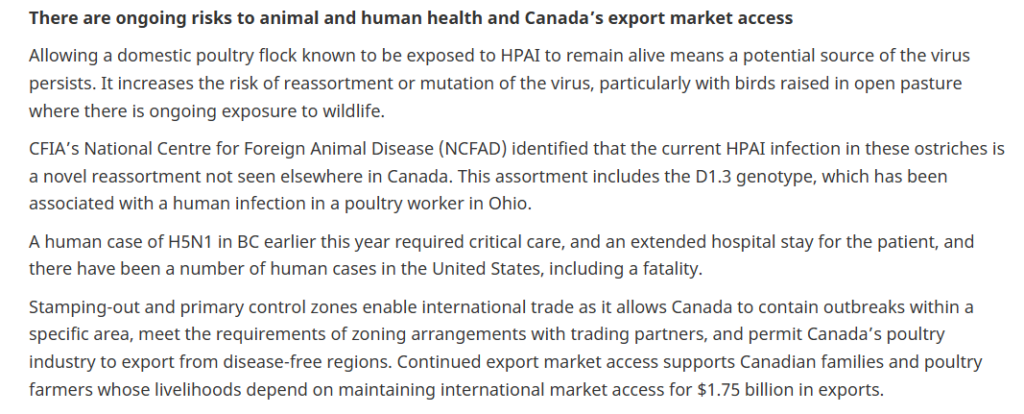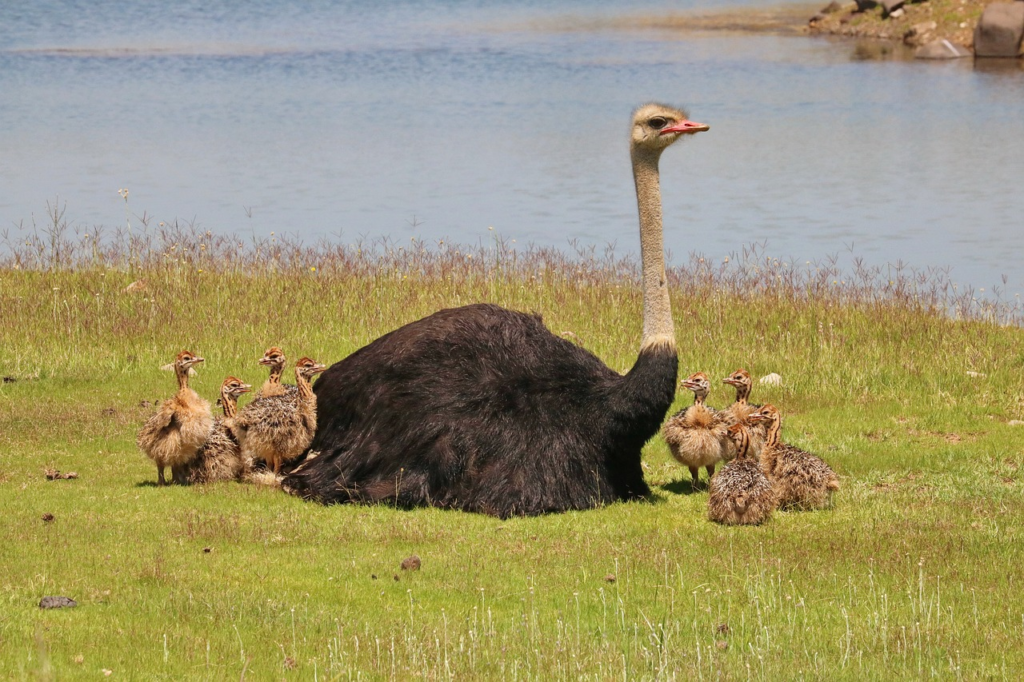In late May, a story started to gain traction about a Canadian ostrich farm and a culling order due to H5N1 in the flock.
Universal Ostrich Farms had been ordered by the Canadian Food Inspection Agency to cull its 400+ ostriches after detecting H5N1 in December 2024. The farm owners challenged the culling order in court. On May 13, the Canadian court ruled in favor of the agency and directed compliance with the culling order.
Why is this dispute so interesting? For several reasons.

Most of the ostriches either recovered or did not get H5N1:
First, by the time the court issued its final ruling, the ostrich farm was no longer infected with H5N1.
But how many birds died? According to the court’s opinion, in total 69 birds died as of January 2025.
The first cases were reported in early December 2024. The farm reported flu-like symptoms in some ostriches. Wild ducks were seen on the farm shortly before the first sick ostriches. The opinion notes that following “an anonymous report” of ostrich deaths, the CFIA put the farm under quarantine. CFIA performed testing and the results were positive for H5N1. A “disposal” order (i.e., culling) swiftly followed.
We typically see culling orders implemented quickly, but in this case the owners fought it.
They argued that the remaining ostriches were either healthy or recovered from H5N1, suggesting some herd immunity to the virus. The farm owners asked for further testing to determine whether any birds were shedding the virus, but the CFIA denied the request. The farm sought an injunction against the culling order.
The court issued its ruling in favor of the CFIA on May 13, 2025. This was long after the last reported ostrich death. Since that time, more news stories have reported the remaining flock is healthy. So the current order is to cull around 400 ostriches not infected with H5N1.
Does this make sense? If the ostriches on this farm aren’t infected, what is the point of killing them? What is there to “stamp out” is there is no longer any H5N1 virus?
Indeed, people are asking these questions. Naturally, those associated with the ostrich farm are very active on social media right now. More and more people are seeking out the farm and posting pictures of their rendezvous with the ostriches. There is an online petition circulating to save the ostriches.

This matter has even gotten the attention of RFK Jr., who has publicly commented that the ostriches shouldn’t be killed and instead should be studied. Even more strange, the “esteemed” Dr. Oz has offered to house the remaining ostriches in Florida. That probably won’t happen, but at least it gave some publicity to this.
Moreover, if the dairy industry isn’t ordered to mass cull it’s infected dairy cows, does it really make sense to continue to order the mass culling of poultry without question? Especially in cases like this, where it’s clear there are hundreds of ostriches that are not sick.
Now I know we are dealing with different countries here. There haven’t been any reported H5N1 outbreaks in Canadian dairy cows. But culling is a globally accepted policy and is the “go to” for “stamping out” H5N1 wherever it is found in poultry. Except here it doesn’t appear to be present anymore.
The H5N1 ostrich virus was a D1 genotype:
Second, according to the CFIA, sequencing of the ostrich viruses showed they belonged to H5N1 clade 2.3.4.4b genotype D1.3. That itself is a bit alarming, as we have seen some evidence that the D1 genotypes might be more virulent, but we’ve also seen mild cases.
This plays into the reasons for culling in the first place: public health. The CFIA outlined those concerns in its recent update on the ostrich situation:

No one wants novel H5N1 reassortants to run rampant through farms. (Unless it’s a dairy cattle farm, then we don’t care.). So the fact that the ostriches tested positive for a D1.3 reassortment is of concern, naturally.
But that was back in December. Had the culling order not been challenged, the ostriches would all be dead by now. But the months long legal battle has created a situation where the surviving birds or non-infected birds are now on the chopping block.
That gives me pause. The underlying purpose of the statutory culling scheme isn’t served anymore. So why go forward with it?
The CFIA did not want to be challenged on its culling order, that much is clear. Typically there probably aren’t many challenges. A commercial poultry operation carries out a culling order quickly. But most commercial poultry operations aren’t anything like this ostrich farm, which leads us to the third reason this case is so interesting.
The farm states that its ostriches are involved in research:
In their attempt to stop the culling, the farm owners argued that their ostrich farm was a platform of certain research. A news article detailing an interview with the farm owners describes the ostrich farm as “a research facility focused on studying the unique antibody-producing capabilities of ostriches,” and this research showed “potential in neutralizing viruses, bacteria, and even COVID-19.”
The Canadian court described this antibody research in its opinion:

However, the CFIA challenges this claim of antibody research. The CFIA maintained that the farm did not provide “formal documentation of research” nor of antibody production at the ostrich farm. The CFIA provides a whole list of things it didn’t receive from the farm owners and views their research claims as “unsubstantiated.”
One exception to mass culling under the CFIA framework is where a poultry flock is proven to have “rare and valuable poultry genetics.” So there has to be something genetically special about the birds in order to avoid their destruction. In the CFIA’s opinion, the antibody research that the owners claim to perform on their farm either doesn’t qualify for this exception or the owners did not meet their evidentiary burden for that exception.
That is essentially what the Canadian court found. In its analysis, the court drew a distinction between the “rare” genetics exception and the farm’s operations, which “focused on commercial applications of ostrich antibodies, business plans, and proposed research projects.” Because this “spoke to potential commercial value of ostrich products generally rather than demonstrating any genetically unique characteristics of the specific birds,” it did not meet the threshold for “rare and valuable poultry genetics” under the law.

Should culling regulations be revisited?
This case is an interesting matter of statutory interpretation combined with burden of proof. In the court’s view, the farm owners did not submit enough evidence to place the work they are doing with these ostriches under the recognized exceptions to the culling order. Was that because studying antibodies has nothing to do with genetics? Probably not. I can see how you could make an argument that such fits under that category. Unfortunately that didn’t work here.
That doesn’t mean that the work with antibodies isn’t important. Indeed, with the continuing circulation of H5N1 through so many new hosts, and the emergence of novel pathogens becoming more of a problem, any leg up could be helpful.
Moreover, the fact that there isn’t some means to stop the culling of birds who are proven to not or no longer be infected with H5N1 seems troubling. We know that H5N1 devastates typical poultry flocks very quickly, which is one of the reasons “stamping out” is the standard procedure. But here, it’s clear that isn’t the case. Most of the ostriches are alive and well.
In it’s opinion, the court took issue with the farm owner’s argument that this was against common sense when other alternatives could be explored. In all fairness, I think the court’s legal analysis was spot on in that courts should be hesitant to second guess the policy decisions and regulatory framework implemented by health agencies like the CFIA. If you go down that road, you end up with the courts making the law rather than applying the law.
But in a broader sense, there is now something wrong with the way we implement mass culling.
So perhaps the problem lies with the parameters of the exceptions under the statute itself. Unfortunately, that is not a question for the courts, but a question for the legislative or regulatory body that made the law in the first place, which the court recognized here.
Don’t get me wrong, I am not against the culling of infected poultry flocks, primarily because that seems to be the best option they can come up with right now. But there are exceptions to every rule, and this ostrich farm feels like an exception.
Especially since dairy cows have become an exception. At least the ostriches have a good reason.
Save the ostriches!
Until next time.
For more bird flu updates and research study analysis, be sure to read my other articles and follow me on social media.
Leave a comment below and join the discussion, and always feel free to reach out to me!


It’s fascinating how this case highlights the tension between standard culling policies and the unique circumstances of this ostrich farm. The argument for herd immunity among the ostriches raises important questions about the effectiveness of blanket culling orders. The CFIA’s refusal to conduct further testing seems to overlook the potential for scientific evidence to inform better decisions. This situation underscores the need for more flexible approaches in managing disease outbreaks. Why is there such resistance to considering alternative solutions when the virus may no longer be active? WordAiApi
You are missing some information here. On the “save the ostriches” facebook site the farm has been refuting some of the CFIA claims. One of those being that no research reports or unique genetic claims were submitted which is untrue. CFIA lawyers explicitly requested that numerous crucial scientific affidavits be stricken from the record during the court hearing. There were volumes of proof submitted by the farm which the CFIA disallowed. The farm was also expected to fill out complicated forms for the genetic claims which were meant for commercial poultry operations which they are not. They could not meet those criteria as an ostrich farm. You also stated that ….We know that H5N1 devastates typical poultry flocks very quickly, which is one of the reasons “stamping out” is the standard procedure. However I think that is an assumption not a fact. Culling happens so fast and to all birds in the affected area based on only a couple of birds tested or even just a suspicion of avian flu. Over 8.7 MILLION birds have been culled since 2022 in just British Columbia alone. This culling and stamping out policy is part of what drove egg prices up so high in the US. I would say that most of these birds were probably perfectly healthy and maybe even had already beat the bird flu. Humans are more susceptible to viruses when we have other problems or comorbidities. The same could probably be true of poultry. The couple overweight chickens got sick and the whole flock is killed as a result. I have not heard of an entire flock or thousands of wild migratory birds being found deceased from the bird flu. Have you? The Stamping out policy comes from the WHO and UN and their ONE HEALTH policies and regulations which most of the world including Canada have signed up to. Our government is not in control of CFIA mandates but have relinquished that control to these world organizations. I wonder who benefits from the mass killing of chickens. Perhaps the corporations waiting to buy up the land as the farmers throw in the towel on farming altogether. Or maybe the suppliers of chicks to replace all these millions that were culled. Culling certainly will not eradicate the bird flu as it is present in migratory birds everywhere. Think about that for a minute.
This case highlights the complexities of disease management in agriculture, especially when it involves rare species like ostriches. The farm owners’ argument for herd immunity raises important questions about the effectiveness of culling in such scenarios. The CFIA’s refusal to conduct further testing seems to disregard the potential for scientific evidence to inform better decisions. The court’s involvement adds a legal dimension to what is primarily a public health issue. Why is the CFIA so resistant to revisiting its decision despite the lack of current H5N1 presence? German news in Russian (новости Германии)— quirky, bold, and hypnotically captivating. Like a telegram from a parallel Europe. Care to take a peek?
This article is a fascinating dive into the complex world of avian flu policy and its real-world impacts on unique cases like the Canadian ostrich farm. The tension between public health mandates and the possibility of retaining valuable research resources is thought-provoking. Its a reminder that one-size-fits-all solutions dont always make sense.
This case is a wild ride—ostriches vs. H5N1 vs. bureaucracy! Who knew feathered research subjects could spark a legal battle this epic? Dr. Oz wanting to rescue them in Florida gives me hope. But seriously, culling healthy birds? Maybe its time for a flu-fighting ostrich superhero team! 🦢💪 #SaveTheOstriches
This is a classic case of ostriches vs. the man! Seriously though, the whole situation is absurd. Culling healthy birds because they *might* have the D1.3 gene? Its like shooting a cannon to kill a gnat! The courts decision feels like theyre stuck on genetics alone, missing the bigger picture. Who cares about rare genetics when youve got a potential antibody goldmine running around? Its fascinating how the farm argues for research while the CFIA seems determined to play it by the book, even if that book is written on a dusty dairy farm. This case really makes you wonder about the rules and whether theres room for some common sense (and maybe a few antibodies) in our fight against bird flu. Time to give these ostriches a fair shake!
Who knew a bunch of ostriches could cause such a legal stir? 😂 Its fascinating how the CFIAs strict culling policy hits a snag with these unique birds. The farms argument about antibody research is creative, though perhaps a bit too niche for the legal systems rare genetics exception. The courts decision highlights the challenge of balancing public health with innovative research. And lets not forget the dairy cows getting a pass – talk about equality issues in the animal kingdom! This case is a hilarious reminder that sometimes, the rigid application of rules can lead to absurd situations. At least the ostriches are getting some attention, right? 🦩💡 #LegalFowlPlayground
This is the bird flus version of a legal drama! Who knew an ostrich farm could be such a hotbed of statutory interpretation? Kudos to the court for calling out the CFIAs potential overreach, but honestly, the whole situation feels like a poultry industry gotcha. The argument about antibodies vs. genetics is a classic, and the courts take on common sense vs. policy is spot on, though I suspect the CFIAs legal eagles werent too thrilled. It’s funny, the farms research claims were apparently less persuasive than, well, anything the CFIA apparently missed. And lets be real, comparing this unique case to the stampede of 8.7 million other birds feels a bit like comparing apples to… well, not apples. This definitely makes you wonder about the fine print in our culling contracts!
Hey! I just want to give an enormous thumbs up for the good information you may have here on this post. I can be coming back to your weblog for extra soon.
I do enjoy the manner in which you have presented this challenge plus it really does provide me some fodder for thought. Nevertheless, coming from what I have seen, I only hope as other feed-back stack on that people today keep on point and in no way embark on a tirade regarding some other news du jour. Still, thank you for this fantastic piece and although I do not necessarily go along with this in totality, I regard your standpoint.
I know of the fact that these days, more and more people will be attracted to cams and the subject of picture taking. However, as a photographer, you will need to first commit so much of your time deciding which model of dslr camera to buy as well as moving store to store just so you could potentially buy the lowest priced camera of the trademark you have decided to pick out. But it would not end at this time there. You also have take into consideration whether you can purchase a digital photographic camera extended warranty. Thanks for the good guidelines I acquired from your site.